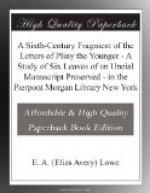In the first place, if our six leaves were once a part of a quaternion, the two leaves needed to complete them must have formed the outside sheet, since our fragment furnishes a continuous text without any lacuna whatever. Now, in the formation of quires, sheets were so arranged that hair side faced hair side, and flesh side flesh side. This arrangement is dictated by a sense of uniformity. As the hair side is usually much darker than the flesh side the juxtaposition of hair and flesh sides would offend the eye. So, in the case of our six leaves, folios 48v and 53r, presenting the flesh side, face folios 49r and 52v likewise on the flesh side; and folios 49v and 52r presenting the hair side, face folios 50r and 51v likewise on the hair side. The inside pages 50v and 51r which face each other, are both flesh side, and the outside pages 48r and 53v are both hair side, as may be seen from the accompanying diagram.
(47) 48 49 50 51 52 53 (54)
: | | | :
| | | :
: | | | Flesh : Flesh
| | | :
: | | +-------:-------+
| | :
: | | Hair : Hair
| | :
: | | :
| | :
: | | Hair : Hair
| | :
: | +------------:------------+
| :
: | Flesh : Flesh
| :
: | :
| :
: | Flesh : Flesh
| :
: +-----------------:-----------------+
:
: Hair : Hair
:
: :
:
: Hair : Hair
:
: — — — —
— — — — — — -:-
— — — — — — —
— — — :
Flesh
Flesh
From this arrangement it is evident that if our fragment once formed part of a quaternion the missing sheet was so folded that its hair side faced the present outside sheet and its flesh side was on the outside of the whole gathering. Now, it was by far the more usual practice in our oldest uncial manuscripts to have the flesh side on the outside of the quire.[2] And as our fragment belongs to the oldest class of uncial manuscripts, the manner of arranging the sheets of quires seems to favor the supposition that two outside leaves are missing. The hypothesis is, moreover, strengthened by another consideration. According to the foliation supplied by the fifteenth-century Arabic numerals, the leaf which must have followed our fragment bore the number 54, the leaf preceding it having the number 47. If we assume that our fragment was a complete gathering, we are obliged to explain why the next gathering began on a leaf bearing an even number (54), which is abnormal. We do not have to contend with this difficulty if we assume that folios 47 and 54 formed the outside sheet of our fragment, for six quires of eight leaves and one of six would give precisely 54 leaves. It seems, therefore, reasonable to assume that our fragment is not a complete unit, but formed part of a quaternion, the outside sheet of which is missing.




